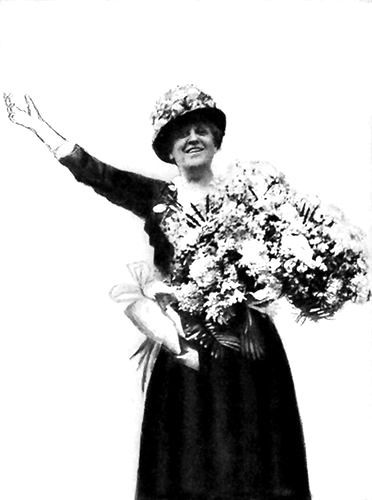Transcriber's Note
Every effort has been made to replicate this text asfaithfully as possible, including obsolete and variant spellings and otherinconsistencies. Text that has been changed to correct an obvious erroris noted at the end of this ebook.
Also, many occurrences of mismatched single and double quotes remainas they were in the original.
This book contains links to individual volumes of "History of Woman Suffrage"contained in the Project Gutenberg collection. Although we verify the correctnessof these links at the time of posting, these links may not work, for various reasons,for various people, at various times.
THE HISTORY
of
Woman Suffrage
EDITED BY
IDA HUSTED HARPER
ILLUSTRATED WITH COPPERPLATE AND PHOTOGRAVURE
ENGRAVINGS
IN SIX VOLUMES
VOLUME VI
1900—1920
IN A TRUE DEMOCRACY EVERY CITIZEN HAS A VOTE
NATIONAL AMERICAN WOMAN SUFFRAGE ASSOCIATION
Copyright, 1922, by
National American Woman Suffrage Association

MRS. CARRIE CHAPMAN CATT.
President of the International Woman Suffrage Alliance from its founding in 1904 and ofthe National American Woman Suffrage Association 1900-1904 and from1915.
Standing in an automobile on the way from the railroad station in NewYork after the campaign for ratification of the Federal SuffrageAmendment was completed by Tennessee. (See page 652.)
INTRODUCTION
WOMAN SUFFRAGE IN THE STATES OF THE UNION
In the preceding volume a full account is given of the forty years'continuous effort to secure an amendment to the Federal Constitutionwhich would confer full suffrage on all the women of the United Statespossessing the qualifications required of men. Antedating thebeginning of this effort by thirty years was the attempt toenfranchise women through the amendment of State constitutions. After1869 the two movements were contemporaneous, each dependent on theother, the latter a long process but essential in some measure to thesuccess of the former. There is no way by which the progress of themovement for woman suffrage can be so clearly seen as by a comparisonof the State chapters in this volume with the State chapters in VolumeIV, which closed with 1900. The former show the remarkable developmentof the organized work for woman suffrage, especially in the lastdecade, which brought the complete victory.
In Volume IV it was possible to give a résumé of the Laws specificallyrelating to women and one was sent with each chapter for this volume.The space occupied by the account of the work for the suffrage,however, made it necessary to omit them. It required thousands ofwords to record the legislation of the last twenty years relatingespecially to women in some of the States and the large pa